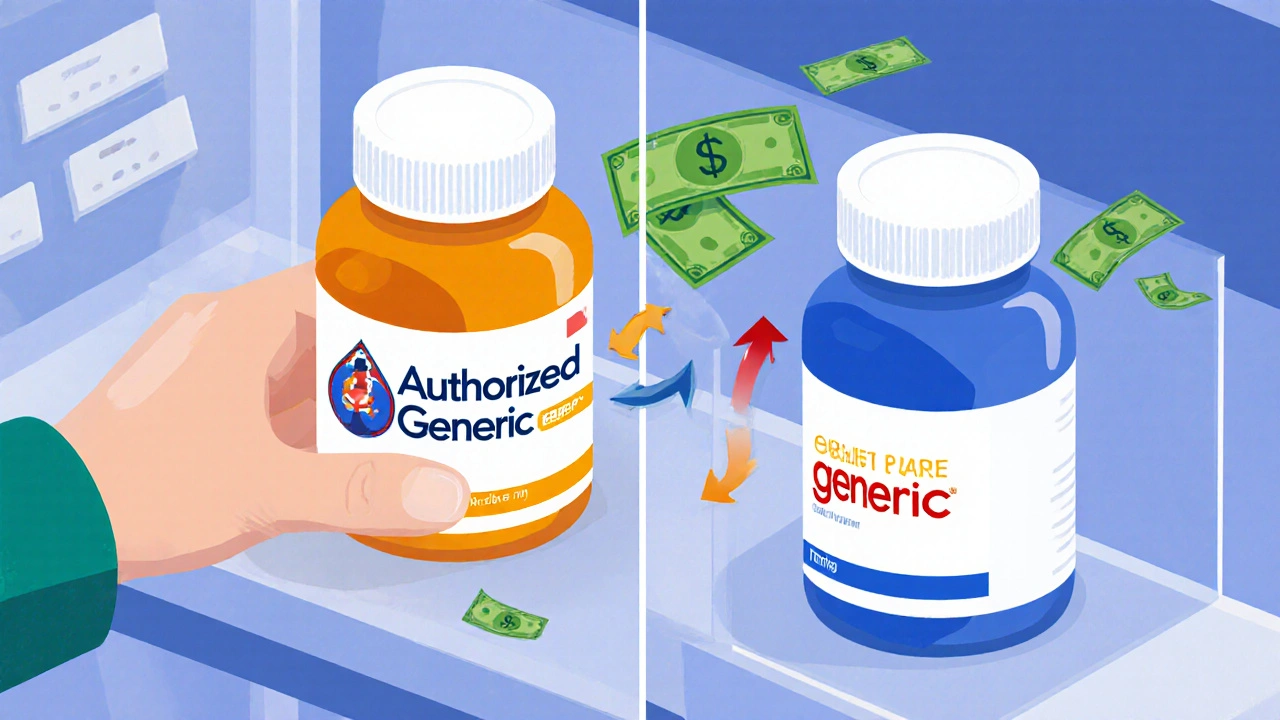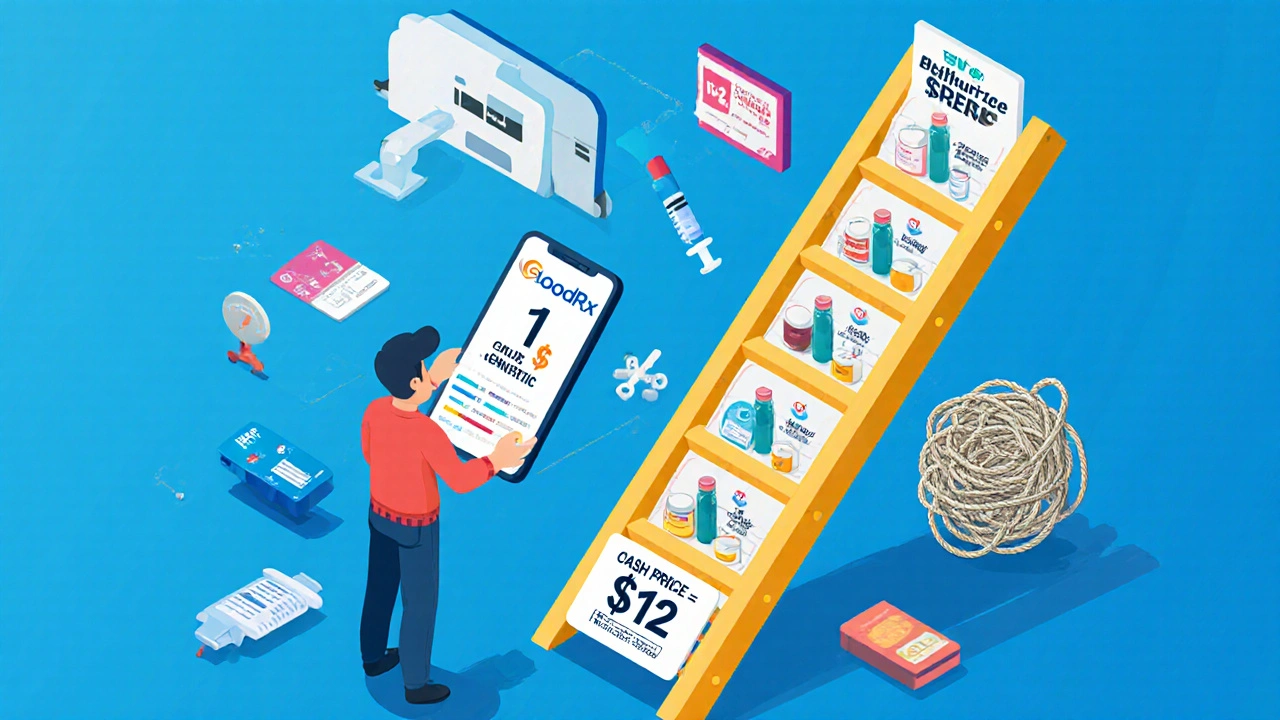Every year, Americans spend over $400 billion on prescription drugs. But here’s the thing: generics are responsible for 90% of all prescriptions filled-and yet they cost just 17.5% of what brand-name drugs do. That’s not a typo. You’re paying way more than you need to if you’re not asking the right questions at the pharmacy.
What’s the Difference Between Generic and Authorized Generic Drugs?
Let’s cut through the confusion. A generic drug is a version of a brand-name medicine made by a different company after the original patent expires. It has the same active ingredient, strength, dosage, and effect. The FDA requires it to be bioequivalent-meaning it works in your body just like the brand. That’s not marketing fluff. It’s science. An authorized generic is different. It’s made by the same company that produces the brand-name drug-but sold under a generic label. Think of it like a car manufacturer selling the exact same vehicle under a budget brand name. No changes to the formula, no different factory. Same pills, same packaging, same batch. The only difference? The label says “generic” and the price is lower. Why does this matter? Because authorized generics often hit the market right when the patent expires. That means they can delay other generic competitors from entering. And while they’re cheaper than the brand, they’re not always the cheapest option. Sometimes, a traditional generic from another company ends up being even cheaper.How Much Can You Actually Save?
The numbers speak for themselves. When a generic hits the market, prices drop fast. In the first year, the cost of a drug can fall by more than 75%. Some drugs-like the HIV medication Truvada-saw prices plunge from $50 per pill to just $3. That’s a 94% drop. Over the past decade, generic drugs have saved the U.S. healthcare system nearly $3 trillion. But here’s where it gets messy: your out-of-pocket cost isn’t always tied to the list price. Insurance plans and pharmacy benefit managers (PBMs) control what you pay at the counter. A drug might cost $5 wholesale, but your copay could still be $40 if your plan puts it on a high tier. Take insulin. One patient switched from brand-name insulin to an authorized generic and saw the list price drop from $350 to $90. But their copay stayed at $45 because their insurance treated the authorized generic differently than a traditional generic. Meanwhile, another patient switched from an authorized generic to a traditional generic for their blood pressure med and saved $20 a month-even though the pills were identical. The lesson? The price you see on the shelf isn’t the price you pay. What matters is how your plan treats each type of generic.What to Say at the Pharmacy
Most pharmacists know generics are cheaper. But not all know the difference between an authorized generic and a traditional one-and even fewer understand how your insurance plan treats them. Here’s what to ask:- “Is there a generic version of this drug available?”
- “Is this an authorized generic?”
- “How does my insurance handle authorized generics versus regular generics?”
- “Can I save money by switching between the two?”
- “What’s the cash price if I don’t use insurance?”

Why Your Insurance Might Not Save You
Even if a drug is $5, your copay might still be $30. Why? Because of formulary tiers. Most insurance plans put drugs into tiers: Tier 1 (cheapest), Tier 2, Tier 3, and so on. Generics usually land in Tier 1. But authorized generics? Sometimes they’re stuck in Tier 2 or even Tier 3. Why? Because PBMs negotiate rebates with manufacturers. Brand companies often give bigger rebates on their authorized generics than traditional generic makers do. So your plan keeps the authorized generic expensive to keep those rebates flowing. The result? You’re paying more even though the drug is the same. Use tools like GoodRx or SingleCare to compare cash prices. Sometimes, paying cash for a traditional generic is cheaper than using your insurance for an authorized generic. One patient saved $18 a month on their cholesterol med by skipping insurance and paying $12 cash for a traditional generic instead of using their $30 copay for the authorized version.What About Biosimilars?
If you’re on a biologic-like Humira, Enbrel, or insulin-you’re not out of luck. Biosimilars are the generic version of biologic drugs. They’re not exact copies (because biologics are made from living cells), but they’re proven to work the same way. And they’re cheaper. On average, biosimilars cost 50% less than the original. As of 2023, over 30 biosimilars are approved in the U.S., and they’ve saved patients and insurers more than $7 billion. Ask your doctor if a biosimilar is an option for you. Many are just as effective, and some are even covered at lower tiers.
What to Watch Out For
There are two big traps: First, don’t assume “generic” means “cheap.” Some authorized generics are priced higher than traditional ones because of how rebates work. Always check the cash price. Second, don’t trust your plan’s list of covered drugs blindly. Formularies change. A drug that was Tier 1 last month might be Tier 3 this month. Call your insurer every six months and ask: “What’s the lowest-cost version of my medication?” Also, be aware of “patent thickets”-when brand companies file dozens of minor patents to delay generics. The FTC estimates this practice costs consumers $3.5 billion a year. It’s not your fault, but knowing it exists helps you push back.Real-World Tips That Work
Here’s what actually helps people save:- Ask for the cash price before using insurance. Sometimes it’s cheaper.
- Use GoodRx coupons-they often beat insurance on generics.
- Switch to mail-order pharmacies. Many offer 90-day supplies at lower copays.
- Ask your doctor for a 30-day trial of a generic before committing.
- If you’re on Medicare, check Part D plans during open enrollment. Some plans have better generic coverage.
Bottom Line: You Have More Power Than You Think
The system is complicated. PBMs, rebates, formularies, and patent games make it hard to know what you’re really paying. But you don’t need to understand all of it. You just need to ask three things every time you fill a prescription:- Is there a generic?
- Is it an authorized generic?
- What’s the lowest price I can pay?
Are generic drugs as safe and effective as brand-name drugs?
Yes. The FDA requires all generic drugs to have the same active ingredient, strength, dosage form, and route of administration as the brand-name version. They must also prove bioequivalence-meaning they work the same way in your body. Over 90% of prescriptions in the U.S. are generics, and they’ve been used safely for decades. The FDA inspects manufacturing facilities for both brand and generic drugs using the same standards.
Why is my authorized generic more expensive than a traditional generic?
It’s not always the case, but sometimes authorized generics are priced higher because your insurance plan negotiates rebates with the brand manufacturer. Even though the pill is identical, the plan may treat it as a higher-tier drug to keep those rebates. Traditional generics often have no such rebate structure, so they can be priced lower. Always compare cash prices using GoodRx or ask your pharmacist for the net cost after rebates.
Can I switch from a brand-name drug to a generic without my doctor’s approval?
In most cases, yes-pharmacists can substitute a generic unless the prescription says “dispense as written” or “no substitutions.” But if you’re switching to an authorized generic or changing between generic types, it’s still smart to check with your doctor, especially for drugs with narrow therapeutic windows like thyroid meds or seizure drugs. Most generics are interchangeable, but your doctor should know what you’re taking.
Why don’t pharmacies always tell me about authorized generics?
Many pharmacists don’t know the difference between authorized and traditional generics-or how insurance treats them. A 2022 survey found only 43% of independent pharmacists could explain how rebate structures affect pricing. That’s why you need to ask. Don’t wait for them to bring it up. Be the one to start the conversation. You’re not being difficult-you’re being informed.
Are there drugs that don’t have generics?
Yes. Some complex drugs-like inhalers, injectables, skin creams, and certain biologics-have no generics yet because they’re hard to copy. But that’s changing. The FDA’s 2023 Drug Competition Action Plan is pushing to speed up approvals for these complex products. In the meantime, biosimilars are available for many biologics, and cash prices for some complex drugs can still be lowered through patient assistance programs or coupons.
If you’re paying more than $20 a month for a generic prescription, you’re likely overpaying. Start asking. Start comparing. And don’t let confusion cost you money.
